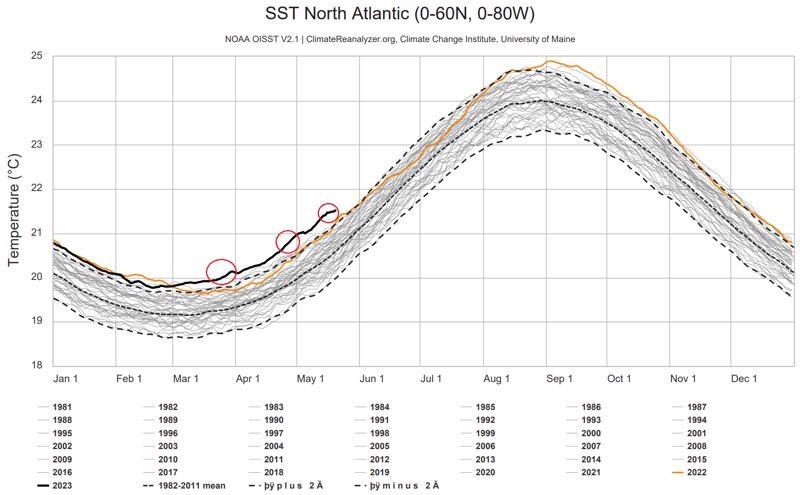
North Atlantic SST Anomalies noted
by Daria Blackwell 30 May 2023 10:40 UTC

SST anomalies in compared with the averages © Ocean Cruising Club
Sea Surface Temperature (SST) and other factors have been noted as deviating from the norms for the North Atlantic in the early months of 2023.
The graph from Climateanalyzer shows the temperature anomalies for the North Atlantic, with the black line representing the year 2023 so far. The ocean temperatures are running higher than normal for this time of year, being the highest ever in known satellite observation. Three marked areas on the graph are temperature peaks in March, April, and May. The ocean surface anomalies for late March show two ocean "hotspots" developed. One area centered around Cape Verde, and the other was further to the north. The peak anomalies in this period already exceeded 4 degrees Celsius.
Analysis by Severe Weather Europe explains what is happening. This part of the ocean is known to have an important connection to the Atlantic hurricane season and the other weather seasons ahead. It can have a profound effect on trade winds and storm patterns. This is not expected in an El Niño year, so we'll have to wait and see which wins out.
Perhaps the Australian prediction of only a 50% chance of an El Niño event this year is justified. There have been instances where global models were suggesting prolonged warming in the ocean, but an El Niño or La Niña event didn't materialise. This happened in 2014 when a strong El Niño was projected but did not occur that year, instead kicking in the following year.
In any case, global SSTs are showing a trend toward increasing ocean temperatures overall, which is not a good sign for the planet. The global oceans are currently running at record high levels, not seen since satellites began measuring SST (since 1980).
This trend is taking place alongside the declining levels of high-latitude sea ice measured during the satellite era as well. The magnitude of the current sea ice extent anomaly (negative) in the Antarctic clearly stands apart relative to any other year for May.
Record low Antarctic sea ice for the date and record warmth in the North Atlantic. Both indicate more energy than ever in the climate system.
This article has been provided by the courtesy of the Ocean Cruising Club